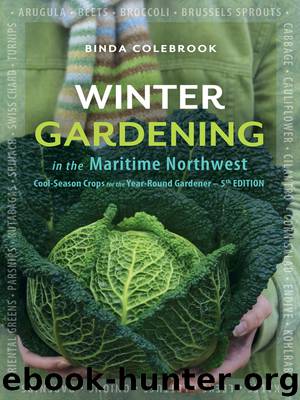Winter Gardening in the Maritime Northwest by Binda Colebrook

Author:Binda Colebrook
Language: eng
Format: epub
Tags: winter gardening, vegetable gardening, regional gardening - Pacific Northwest
ISBN: 9781550925005
Publisher: New Society Publishers
Published: 2012-05-06T16:00:00+00:00
The other kinds of kale do not transplant well. They stem from B. napus and include Siberian, Ragged Jack, Russian, Hanover and Asparagus Kale. These forms are related to the rapes and rutabagas (they have a different number of chromosomes than the B. oleracea types) and include some of the superior salad kales.
T
hese types can be sown directly in July or August on 18-inch centers. If you are worried about germination, sow a few extra seeds and then thin (feed thinnings to the livestock in September or eat them yourself). Unless your soil is awful, don’t manure or fertilize before you sow; the plants will grow too fast and won’t be as hardy.
I used to have three to six plants of the tall curly kale, and two to three of the Siberian, which feeds a two-person family plus five to seven chickens that have partial free range. You can use the curled through March, when it starts to flower and you’ve cut all the sprouts of any size. Then pull it up, turn in the soil, and turn your attention to the Siberian. It will last approximately another month in a cool spring. The flowers of these or any other brassica are delicious in salads, so I usually leave one plant of some type somewhere in the garden. I like dwarf Siberian for eating raw, especially in spring when the new sprouts and leaves are very tender. Some folks I know eat Scotch and the green curled varieties raw too, but I find them tough and strong-flavored (except in the spring), even though they do improve after a few frosts. I prefer them in soups, stews and frittatas, where they are delicious. Russian is a tender, very attractive kale, striking in salads at all times of the year. But it is not terribly hardy and will die out around 25°F (–4°C). Its best quality is that you can start it all through the summer and it won't bolt on you or turn bitter (except perhaps in a very hot July or August).
Many years ago, in a fit of careless abandon, I let the best of the kales and Asian brassicas in my garden go to flower together. Miscegenation! Then I let the seed ripen and fall about. That autumn I had various forms of kale all over the place; it was very interesting. I left them alone, except for thinning them a bit, especially in the beds. A year or so later, I caught on and let it happen every year. I had been doing the same with corn salad for a while. I couldn't see much difference in the varieties that companies offered, and since corn salad is a "weed of cultivation," I figured it wouldn't make much difference. I did the same and had similar results with dill, coriander and amaranth, although with amaranth, the wonderful colored varieties died out, and it all reverted to the plain green weed. I suppose that was because of the shadiness of that particular garden.
Download
This site does not store any files on its server. We only index and link to content provided by other sites. Please contact the content providers to delete copyright contents if any and email us, we'll remove relevant links or contents immediately.
| Colder Climates | Desert |
| Temperate | Tropical |
Turbulence by E. J. Noyes(7031)
The Thirst by Nesbo Jo(5777)
Gerald's Game by Stephen King(3913)
Be in a Treehouse by Pete Nelson(3204)
Marijuana Grower's Handbook by Ed Rosenthal(3112)
The Sprouting Book by Ann Wigmore(3049)
The Red Files by Lee Winter(2907)
The Remains of the Day by Kazuo Ishiguro(2613)
Sharp Objects: A Novel by Gillian Flynn(2439)
Christian (The Protectors Book 1) by L. Ann Marie(2392)
Organic Mushroom Farming and Mycoremediation by Tradd Cotter(2304)
The Culinary Herbal by Susan Belsinger(2055)
Stone Building by Kevin Gardner(1992)
The Starter Garden Handbook by Alice Mary Alvrez(1922)
Lilac Girls by Martha Hall Kelly(1868)
The Unlikely Pilgrimage of Harold Fry by Rachel Joyce(1833)
The Lean Farm Guide to Growing Vegetables: More In-Depth Lean Techniques for Efficient Organic Production by Ben Hartman(1781)
Urban Farming by Thomas Fox(1748)
Backyard Woodland by Josh VanBrakle(1586)
